
Wetenschap
Microalgen beloven overvloedig gezond voedsel en voer in elke omgeving
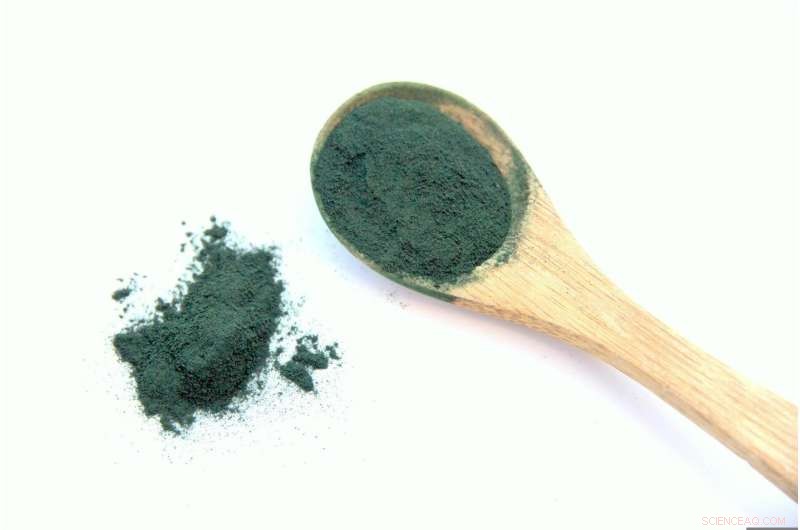
Spirulina, een blauwgroene microalg, is een uitstekende bron van micronutriënten en eiwitten. Krediet:Anaïs CROUZET via Pixabay
De wereldwijde voedselvoorziening wordt geconfronteerd met een reeks bedreigingen, waaronder klimaatverandering, oorlogen, plagen en ziekten. Een organisme dat te klein is voor het menselijk oog om te zien - microalgen - zou enkele antwoorden kunnen bieden.
Het voeden van een groeiende wereldbevolking die volgens de voorspellingen van de Verenigde Naties in 2050 9,8 miljard zal bereiken, en de noodzaak om natuurlijke hulpbronnen voor toekomstige generaties te behouden, lijkt in eerste instantie tegenstrijdig.
Maar een oplossing, hoewel nog niet in zicht, is zeker niet buiten bereik. Europese wetenschappers hebben onlangs een honger naar microalgen ontwikkeld, ook wel fytoplankton genoemd, een subgroep van algen bestaande uit eencellige fotosynthetische micro-organismen.
De meeste mensen kennen de grootste vorm van algen, kelp of zeewier. Hij kan tot drie meter lang worden en is in sommige vormen een bekende delicatesse. De verwante soorten microalgen, die zowel in zeewater als in zoet water te vinden zijn, hebben aandacht gekregen in onderzoek vanwege hun buitengewone eigenschappen.
Deze microscopisch kleine organismen kunnen worden gebruikt voor diervoeding, met name in de aquacultuur, en verschillende voedingsmiddelen, waaronder pasta, veganistische worsten, energierepen, bakkerijproducten en plantaardige crèmes.
De meeste commerciële microalgenkweekcentra richten zich op de productie van gedroogde biomassa zoals chlorella of spirulinapoeder als voedsel dat aanzienlijke gezondheidsvoordelen biedt. Sommige microalgenstammen accumuleren niet alleen tot 65-70% eiwit, maar zijn ook duurzame bronnen van omega-3-vetzuren - een stof die conventioneel voornamelijk wordt gewonnen uit vis en visolie.
Extra bioactieve stoffen, zoals vitamine B12, K of D, betekenen dat microalgen significante gezondheidseigenschappen bevatten, waardoor het risico op kanker en hart- en vaatziekten mogelijk wordt verminderd.
Woestijnalgen
"Microalgen kunnen op veel verschillende locaties worden gekweekt, onder zeer verschillende omstandigheden", zegt Massimo Castellari, die betrokken is bij het door Horizon gefinancierde ProFuture-project dat gericht is op het opschalen van de productie van microalgen. "We kunnen het telen in IJsland en in een woestijnklimaat."
De technologieën voor de intensieve teelt van microalgen zijn sinds de jaren vijftig in ontwikkeling.
Tegenwoordig worden microalgen gekweekt in fotobioreactoren met een open of gesloten systeem, dit zijn vaten die zijn ontworpen om de productie van biomassa te regelen. De versie met gesloten systeem, hoewel duurder om te bouwen, biedt meer controle over experimentele parameters en minder risico op besmetting.
De stof is zeker niet zomaar een trendy voedingssupplement. In Tsjaad bijvoorbeeld, een geheel door land omgeven land met een laag inkomen, heeft de consumptie van spirulina, geoogst uit het Tsjaadmeer, de voedingsstatus van mensen aanzienlijk verbeterd, omdat spirulina een uitstekende bron van eiwitten en micronutriënten is.
On top of its nutritional value, microalgae offer climate benefits by sequestering carbon dioxide as well as economic advantages by using farming areas more efficiently and—through the use of non-arable land—expanding the possibility of biomass production.
With a total of less than 57,000 tons cultivated in 2019, according to the UN Food and Agriculture Organization (FAO), production of microalgae is still very much in its early stages. By comparison, primary-crop output was 9.4 billion tons in 2019.
Food inflation
Russia's continuing war in Ukraine has highlighted just how vulnerable global food supply can be. Halts to Ukrainian grain exports and increases in energy prices have helped push food inflation around the world to record highs, with developing countries being hit disproportionately hard. In May this year, costs for food had risen by 42% compared with 2014–2016, the UN reported.
Last year, as many as 828 million people were affected by hunger—an increase of roughly 46 million compared with 2020 and a surge of 150 million since the outbreak of the COVID-19 pandemic.
The FAO projects that some 670 million people will still face hunger by the end of the decade.
While the benefits of cultivating organic microalgae for food and feed are substantial, market growth will require overcoming obstacles including a lack of automated production in the industry, according to Castellari, who works at the Institute of Agrifood Research and Technology in Barcelona, Spain.
"The automatization is still not completely implemented," he said. "There are small producers in Europe—many steps still involve manual labor. So they are still working on optimizing the process."
Processed biomass
The challenges go well beyond cultivation. With microalgae, biomass has to be processed, cleaned and dried before a usable powder can be obtained. The next step is to scale up production to drive down costs.
In addition, there are regulatory challenges. Only a few species of microalgae are currently authorized in the European Union.
"In Europe it's still in a preliminary stage of development," said Castellari. "There are thousands of species of microalgae, but for food consumption or feed there are only seven species authorized."
To gain knowledge about the possibilities to use other species, Castellari and his team are also investigating these other kinds of microalgae.
Due to these challenges, the portfolio of products containing microalgae remains limited today. But, if these hurdles can be overcome, the overall prospects for the microalgae industry are promising. Besides being a source of food and feed, the plant can be used for biofuels, cosmetics, fertilizer and health supplements.
Astaxanthin, a blood-red pigment extracted from algae, already has notable uses. A powerful antioxidant, astaxanthin can be found in seafood and is commonly used to color shrimp. It is also sold in the form of pills as a food supplement.
Astaxanthin is thought to have potentially a positive impact on brain function, athletic performance and aging skin, among other things.
Matteo Ballottari, associate professor of biotechnology at the University of Verona in Italy, helped start the European Research Council's Horizon-funded project AstaOmega simultaneously to produce astaxanthin and omega-3 fatty acids in microalgae for aquaculture and human nutrition.
Quality and quantity
Most omega-3 supplements are derived from fish oils. This, however, raises sustainability concerns such as damage to marine ecosystems as a result of overfishing.
"There is more demand for eating high-quality foods, along with an awareness for incorporating omega-3 rich ingredients in our diets," Ballottari said. Responding to this trend while feeding a growing world population is 'a big challenge," he said.
Meanwhile, on the astaxanthin front, the AstaOmega researchers have made progress. They have been able to obtain a new strain that can produce astaxanthin on its own, without needing to be "stressed." This means the researchers don't have to change production parameters such as light intensity, temperature or nitrates concentration. Also, extracting the substance has become easier, resulting in lower costs.
Scientists agree that microalgae have the potential to change the ways in which we eat for the better.
"Microalgae can help us to increase the protein production within Europe to reduce our dependence on other countries," said Castellari of the ProFuture project. + Verder verkennen
Large-scale cultivation of microalgae can clean emissions from industry, can also be used in Nordic climate
 Wetenschappers ontwikkelen een nieuwe methode om de efficiëntie van luchtreinigers te verbeteren
Wetenschappers ontwikkelen een nieuwe methode om de efficiëntie van luchtreinigers te verbeteren Een eenvoudige methode ontwikkeld voor 3D-biofabricage op basis van bacteriële cellulose
Een eenvoudige methode ontwikkeld voor 3D-biofabricage op basis van bacteriële cellulose Watermoleculen splitsen voor een toekomst met hernieuwbare energie
Watermoleculen splitsen voor een toekomst met hernieuwbare energie Kunnen tweelinggrenzen bestand zijn tegen vermoeiingsscheuren?
Kunnen tweelinggrenzen bestand zijn tegen vermoeiingsscheuren? Chemici maken doorbraak op weg naar het maken van een oplaadbare lithium-zuurstofbatterij
Chemici maken doorbraak op weg naar het maken van een oplaadbare lithium-zuurstofbatterij
 Who Lives in the Tundra?
Who Lives in the Tundra?  Verzoening van verschillen in interpretaties van de onderbreking van de opwarming van de aarde
Verzoening van verschillen in interpretaties van de onderbreking van de opwarming van de aarde Numeriek model lokaliseert bron van voorloper van seismische signalen
Numeriek model lokaliseert bron van voorloper van seismische signalen De branden in het Amazonebekken in Brazilië blijven toenemen
De branden in het Amazonebekken in Brazilië blijven toenemen Stanford-onderzoeker onderzoekt onbezongen held van de wetenschap:beoordeling
Stanford-onderzoeker onderzoekt onbezongen held van de wetenschap:beoordeling
Hoofdlijnen
- Sleutel tot betere asperges geïdentificeerd in evolutie van geslachtschromosomen
- Wat zijn de biomoleculen van ribosomen?
- Hoe water door planten beweegt
- Flagella: soorten, functie en structuur
- Dieetbeperking en levensduur bij mannelijke en hermafrodiete wormen
- Computersimulaties visualiseren hoe een essentieel stamceleiwit verpakt DNA opent
- Wat doet de DNA-nucleotide volgorde code voor?
- Nepal op schema om doel van verdubbeling tijgerpopulatie tegen 2022 te halen
- Wetenschappers publiceren het genoom van de waterbuffel
- Dolfijnen vormen grootste alliantienetwerk buiten mensen, studie vondsten
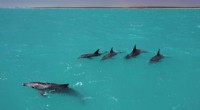
- Het eten van insecten kan goed zijn voor de planeet. Europeanen zouden er meer van moeten eten
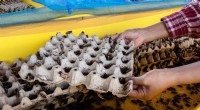
- Een geprioriteerde lijst van invasieve uitheemse soorten die het milieu van het VK bedreigen
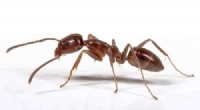
- Emotionele toestanden ontdekt in vissen
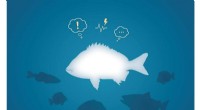
- Waarom lijken oude stellen op elkaar?

 Een nieuwe theorie van kwantumsystemen met veel deeltjes op de proef stellen
Een nieuwe theorie van kwantumsystemen met veel deeltjes op de proef stellen Het begrijpen van het dierenbrein kan robots helpen om je afwas te doen
Het begrijpen van het dierenbrein kan robots helpen om je afwas te doen Waarom zijn luchtgedroogde handdoeken zo stijf?
Waarom zijn luchtgedroogde handdoeken zo stijf? Hoe bacteriën worden gereproduceerd?
Hoe bacteriën worden gereproduceerd?  Zware sneeuw, harde wind richt schade aan in heel Europa
Zware sneeuw, harde wind richt schade aan in heel Europa Zwermsatellieten onthullen magnetische golven die het buitenste deel van de buitenste kern van de aarde overspoelen
Zwermsatellieten onthullen magnetische golven die het buitenste deel van de buitenste kern van de aarde overspoelen Gestandaardiseerde tests zijn cultureel bevooroordeeld tegen plattelandsstudenten
Gestandaardiseerde tests zijn cultureel bevooroordeeld tegen plattelandsstudenten Modder uit de diepe zee onthult aanwijzingen over oude moesson
Modder uit de diepe zee onthult aanwijzingen over oude moesson
- Elektronica
- Biologie
- Zonsverduistering
- Wiskunde
- French | Italian | Spanish | Portuguese | Swedish | German | Dutch | Danish | Norway |

-
Wetenschap © https://nl.scienceaq.com

